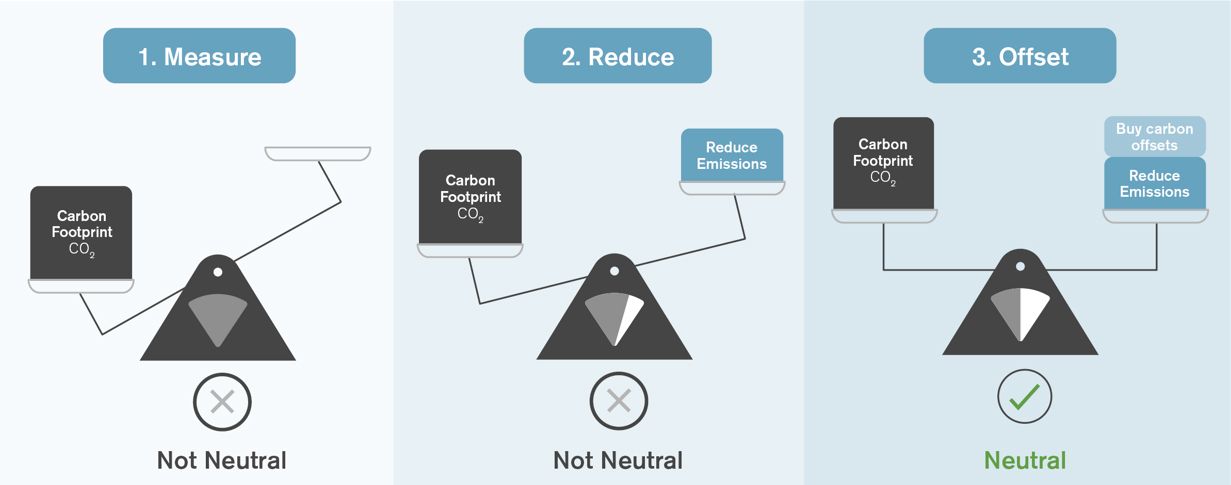The world of sustainability and climate change can seem complex with its many terms and interpretations, in the Sustainability Unravelled series, we take a key term or trend, break it down to the key facts and provide ideas on the best questions to ask to compare products and services accurately.
Carbon offsets – what are they?
Carbon offset schemes allow individuals and companies to invest in credits in environmental projects to balance out their own carbon footprints. Having measured the related emissions relating to a product or service, you look to offset them against another separate and unrelated process that prevents the release of greenhouse gases or actually removes them. Types of commonly used offset projects include renewable energy projects, reforestation schemes, cook stove distribution to capturing methane in landfills.
What is the debate on carbon offsets?
Some critics claim that offsets are just a way for an individual or company to buy their way out of their responsibility for greenhouse gas emissions. That they are a way to avoid changing an unsustainable business. In some countries the translation of carbon offsets is carbon compensation – and the suggestion here is that the compensatory element does not require you to change a product, service or behaviour.
What’s the reality?
To me, this rationale serves as a useful warning. However, I believe that looking at offsetting in this way is only part of the picture. I would argue that, if used responsibly, carbon offsets definitely have their place to help encourage manufacturers to implement carbon footprint reductions, as they provide a stepping stone toward making your business or product carbon neutral.
Once you have measured your carbon impact, the use of offsets can be used to incentivise further innovation that reduces that impact. The more successful the company is in reducing carbon emissions, the less offsets are required and the more appealing a product is to a carbon-conscious customer.
If used wisely and responsibly, offsets can be used to encourage the reduction of a product’s carbon footprint – that is, if work is continually made to reduce the carbon footprint, and the offsets are strictly for the small remainder that cannot be removed or reduced.
Interface’s use of carbon offsets
At Interface, we use carbon offsets as part of our Carbon Neutral Floors. All of our products – whether carpet tile, LVT or nora® rubber flooring are carbon neutral for their whole lifecycle. We achieved this by measuring emissions throughout the products lifecycle. Once we were aware of these we set about identifying areas to reduce emissions – for example using more renewable energy, using less materials or using more recycled or bio-based materials. Taking action like this enabled us to reduce the carbon footprint of our carpet tile products by over 76% (since 1996). With the remainder we do use high quality carbon offsets, supporting a portfolio of projects around the planet that include renewable energy, reforestation, clean water and fuel swapping. It is our intention to continually innovate to reduce the carbon footprint of our products – so ultimately, we want to find ways to use less offsets.
We’ve been using carbon offsets since 2003, and it has allowed us to spark conversations on carbon with customers. To date we have sold more than 419 million square meters of carbon neutral flooring globally, and we have retired approximately 5.7 million metric tons of verified emission reduction credits. That’s equivalent to the emissions from 1.3 million cars (based on annual use), which represents a lot of journeys.
Key questions to ask on carbon offsets
If you’re considering a product that has a carbon neutral claim, here’s a few questions to help inform you on the responsible use of offsets:
- What steps have been taken to reduce the carbon impact of a product/service?
- Is the product carbon neutral? Is it so, for its whole life cycle?
- Are carbon offsets utilised and what kinds of project are supported?
- Are the carbon offsets verified to Gold Standard, Voluntary Carbon Standard or equivalent?
